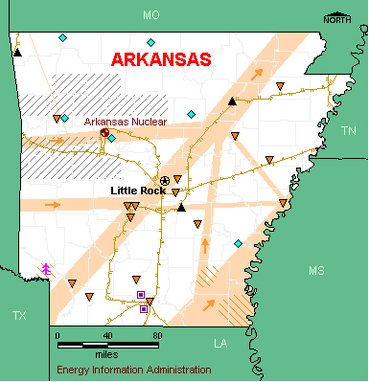Energy profile of Arkansas, United States
Contents
Quick Facts
- Coal-fired plants, which supply about one-half of Arkansas’s electricity demand, rely entirely on coal deliveries via railcar from Wyoming.
- Arkansas natural gas production accounts for about 1 percent of U.S. output.
- Companies are beginning to extract small amounts of natural gas from coal bed methane deposits in the Arkoma basin.
- Arkansas is one of the few States in the Nation that allow the use of conventional motor gasoline statewide.
Overview (Energy profile of Arkansas, United States)
Resources and Consumption
 Map of Arkansas energy infrastructure. (Source: EIA)
Map of Arkansas energy infrastructure. (Source: EIA) Arkansas has moderate energy resources. Substantial natural gas reserves are found in the Arkoma basin in western Arkansas and in the Gulf Coastal Plain in the south. Smaller oil reserves and coal deposits are also found in those regions. Several river basins, including the Lower Arkansas River, offer hydroelectric power potential. Areas of the State are also suitable for wind, wood, and wood waste power generation. Per capita energy use is high due in part to an energy-intensive industrial sector, which leads State energy consumption.
Petroleum
Arkansas extracts small amounts of crude oil mostly from stripper wells that produce less than 10 barrels per day in the southern part of the Gulf Coastal Plain of south Arkansas. Arkansas has two refineries located in the same region. Petroleum products are delivered to consuming regions by barge via the Arkansas and Mississippi Rivers. The TEPPCO pipeline also supplies petroleum products from Texas and Louisiana. Arkansas is one of the few States in the Nation that allow the statewide use of conventional motor gasoline. (Most States require the use of special fuel blends in non-attainment areas.)
Natural Gas
Arkansas natural gas production typically accounts for about 1 percent of annual U.S. output. Most of the State’s natural gas production takes place in the Arkoma Basin, although several wells also operate in the Gulf Costal Plain. In addition to conventional production, companies are beginning to extract small amounts of natural gas from coal bed methane deposits in the Arkoma Basin. Several major natural gas pipelines from Texas, Louisiana, and |Oklahoma pass through the State on the way to Midwest and Northeast markets. Industrial sector natural gas consumption in Arkansas has declined in recent years. Until 2001, the industrial sector accounted for more than half of the State’s natural gas consumption but this share had fallen to two-fifths by 2005. Almost one-half of Arkansas households use natural gas as their primary energy source for home heating.
Coal, Electricity, and Renewables
Coal and nuclear power are the dominant energy sources used for electricity generation in Arkansas, although natural gas and hydroelectric power are also important energy sources. Coal-fired power plants account for about one-half of the electricity produced within the State, and these plants rely entirely on coal deliveries from |Wyoming. The State’s only nuclear plant (the dual-unit Arkansas Nuclear One Plant in Russellville) typically generates more than one-fourth of the total electricity generated in the State. Hydroelectric power plants in the White River Basin in the north, along the Arkansas River in central Arkansas, and in the Ouachita River Basin in the south also contribute to electricity supply. About one-third of Arkansas households use electricity as their primary energy source for home heating.
Data
See the Energy Information Administration's Energy profile of Arkansas for more information on the state's energy use, including data on Economy, Prices, Reserves & Supply, Distribution and Marketing, Consumption, and Environment.
Related Reports
- State Consumption, Prices and Expenditures (SEDS) tables that display comprehensive State data from as early as 1960 to the present.
- State Electricity Profiles tables that provide time series data from 1990 forward for key electricity indicators by State.
- State Compendium of Nuclear Power Plants State-by-State reports on the nuclear industry.
- Natural Gas Residential Choice Programs written overviews of the status of natural gas industry restructuring in each State, focusing on the residential customer class.
- Status of Electricity Restructuring by State annotated map showing details of the status of electricity restructuring in each State.
- Regional Energy Profiles reports and maps that explore regional variations in U.S. energy consumption.
References
| Disclaimer: This article is taken wholly from, or contains information that was originally published by, the Energy Information Administration. Topic editors and authors for the Encyclopedia of Earth may have edited its content or added new information. The use of information from the Energy Information Administration should not be construed as support for or endorsement by that organization for any new information added by EoE personnel, or for any editing of the original content. |